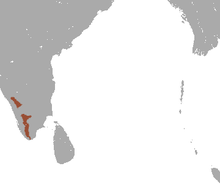Nilgiri langur
| Nilgiri langur[1] | |
|---|---|
_by_N._A._Naseer.jpg) | |
| Scientific classification | |
| Kingdom: | Animalia |
| Phylum: | Chordata |
| Class: | Mammalia |
| Order: | Primates |
| Family: | Cercopithecidae |
| Subfamily: | Colobinae |
| Genus: | Semnopithecus |
| Species: | S. johnii |
| Binomial name | |
| Semnopithecus johnii (J. Fischer, 1829) | |
 | |
| Nilgiri langur range | |
| Synonyms | |
|
Trachyputhecus johnii | |
The Nilgiri langur (Semnopithecus johnii)[3] is a langur (a type of Old World monkey) found in the Nilgiri Hills of the Western Ghats in South India. Its range also includes Kodagu in Karnataka, Kodayar Hills in Tamil Nadu, and many other hilly areas in Kerala and Tamil Nadu. This primate has glossy black fur on its body and golden brown fur on its head. It is similar in size and long-tailed like the gray langurs. Females have a white patch of fur on the inner thigh. It typically lives in troops of nine to ten monkeys.[2] Its diet consists of fruits, shoots and leaves. The species is classified as vulnerable due to habitat destruction and poaching for its fur and flesh, the latter believed to have aphrodisiac properties.[4]
Taxonomy and Classification
The classification of the Nilgiri langur has been disputed. Traditionally it has been placed within the genus Trachypithecus based on morphological similarities such as cranial morphology and neonatal pelage color, and within the Trachypithecus vetulus group within Trachypithecus based on a presumed close relationship with the purple-faced langur, which had been classified as Trachypithecus vetulus. DNA and other evidence suggests that the Nilgiri langur and purple-faced langur are more closely related to the gray langurs and have thus been reclassified within the genus Semnopithecus.[5][6][7][8][3][9]
Description
The head-plus-body length is 78–80 cm in adult males and 58–60 cm in adult females, with the tail adding between 68.5 and 96.5 cm. The males weigh 9.1-14.8 kg, the females 10.9–12 kg.[4] The gestation period is not precisely known but assumed to be similar to the closely related Hanuman Langur, i.e. 200 days.[4]
References
- ↑ Groves, C.P. (2005). Wilson, D.E.; Reeder, D.M., eds. Mammal Species of the World: A Taxonomic and Geographic Reference (3rd ed.). Baltimore: Johns Hopkins University Press. p. 178. ISBN 0-801-88221-4. OCLC 62265494.
- 1 2 Singh, M.; Kumar, A. & Molur, S. (2008). "Trachypithecus johnii". The IUCN Red List of Threatened Species. IUCN. 2008: e.T44694A10927987. doi:10.2305/IUCN.UK.2008.RLTS.T44694A10927987.en. Retrieved 12 January 2018.
- 1 2 "Semnopithecus johnii". ITIS. Retrieved 2018-08-27.
- 1 2 3 Malviya, M.; Srivastav, A.; Nigam, P.; Tyagi, P. C. (2011). "Indian National Studbook of Nilgiri Langur (Trachypithecus johnii)" (PDF). Wildlife Institute of India, Dehradun and Central Zoo Authority, New Delhi.
- ↑ Wilson, Don E.; Mittermeier, Russell A.; Rylands, Anthony B. (2012). "Introduction". Handbook of the Mammals of the World, Volume 3: Primates (1st ed.). Lynx Edicions. ISBN 978-8496553897. Retrieved 2018-08-30.
- ↑ Osterholz, Martin; Walter, Lutz & Roos, Christian (2008). "Phylogenetic position of the langur genera Semnopithecus and Trachypithecus among Asian colobines, and genus affiliations of their species groups". BMC Evolutionary Biology. 8 (58). doi:10.1186/1471-2148-8-58. Retrieved 2018-08-27.
- ↑ Brandon–Jones, D.; et al. (2004). "Asian Primate Classification". International Journal of Primatology. 25 (1). Retrieved 2018-08-28.
- ↑ Xiao Ping Wang; et al. (April 27, 2012). "Phylogenetic Relationships among the Colobine Monkeys Revisited: New Insights from Analyses of Complete mt Genomes and 44 Nuclear Non-Coding Markers". plos.org. Retrieved 2018-08-28.
- ↑ Karanth, K. Praveen; et al. (2008). "Molecular phylogeny and biogeography of langurs and leaf monkeys of South Asia (Primates: Colobinae)" (PDF). Molecular Phylogenetics and Evolution. 46: 683–694. doi:10.1016/j.ympev.2007.11.026. Retrieved 2018-08-30.
External links
| Wikimedia Commons has media related to Trachypithecus johnii. |
| Wikispecies has information related to Nilgiri langur |
